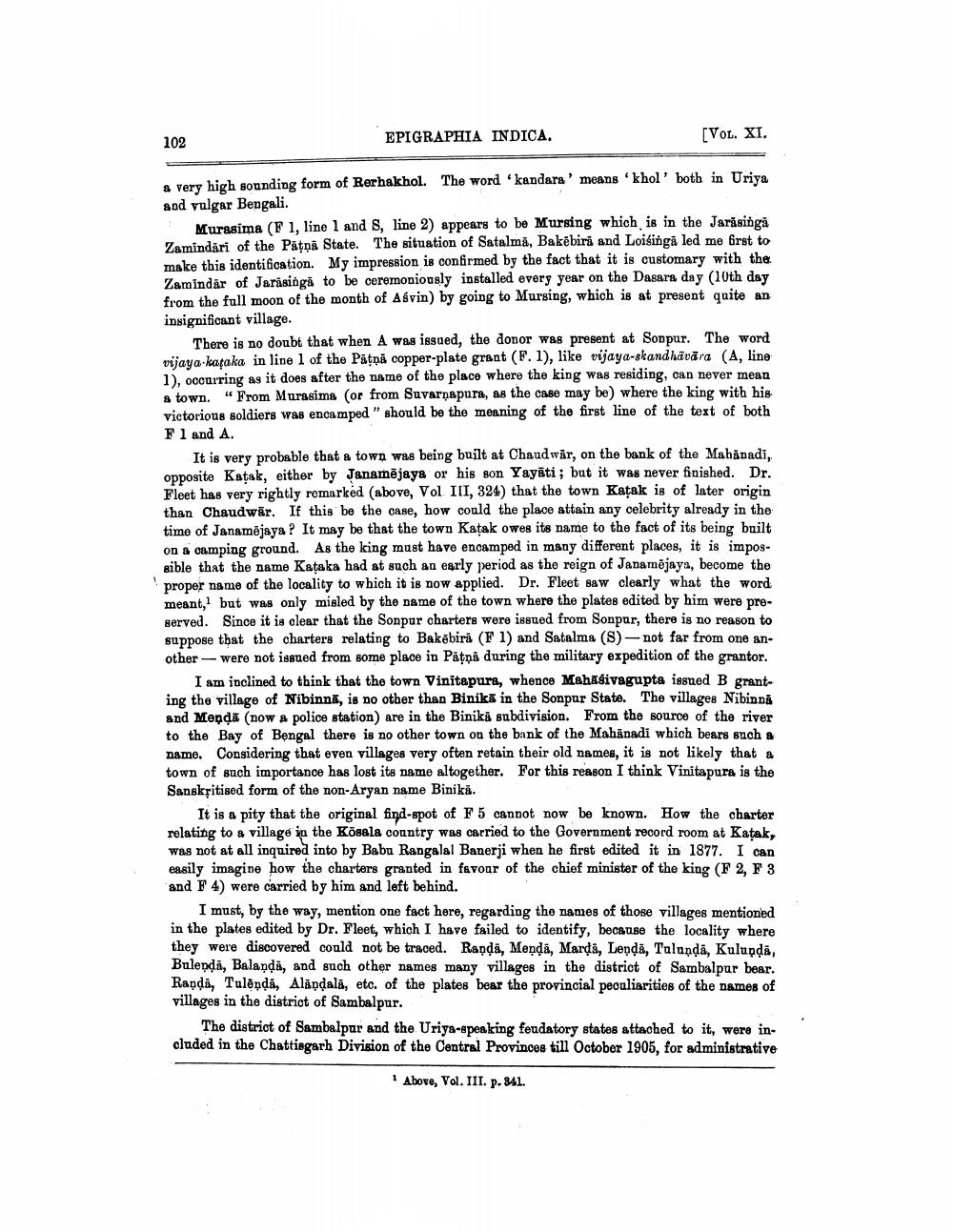________________
102
EPIGRAPHIA INDICA.
[VOL. XI.
a very high sounding form of Rerhakhol. The word 'kandara' means 'khol' both in Uriya and vulgar Bengali
Murasima (F 1, line 1 and 8, line 2) appears to be Mursing which is in the Jarasingă Zamindari of the Patna State. The situation of Satalma, Bakëbiri and Loisingi led me frst to make this identification. My impression is confirmed by the fact that it is customary with the Zamindar of Jarasinga to be ceremoniously installed every year on the Dasara day (10th day from the full moon of the month of Asvin) by going to Mursing, which is at present quite an insignificant village.
There is no doubt that when A was issued, the donor was present at Sonpur. The word vijaya kapaka in line 1 of the Patni copper-plate grant (F. 1), like vijaya-skandhävāra (A, line 1), occurring as it does after the name of the place where the king was residing, can never mean & town. "From Murasima (or from Suvarnapura, as the case may be) where the king with his victorious soldiers was encamped " should be the meaning of the first line of the text of both F 1 and A.
It is very probable that a town was being built at Chaudwår, on the bank of the Mahånadi, opposite Katak, either by Janamējaya or his son Yayati; but it was never finished. Dr. Fleet has very rightly remarked above, Vol III, 324) that the town Kaçak is of later origin than Chaudwār. If this be the case, how could the place attain any celebrity already in the time of Janamējaya ? It may be that the town Katak owes its name to the fact of its being built on a camping ground. As the king must have encamped in many different places, it is impossible that the name Kataka had at such an early period as the reign of Janamöjaya, become the proper name of the locality to which it is now applied. Dr. Fleet saw clearly what the word meant, but was only misled by the name of the town where the plates edited by him were preserved. Since it is clear that the Sonpur charters were issued from Sonpur, there is no reason to suppose that the charters relating to Bakēbiră (F 1) and Satalma (S) - not far from one another - were not issued from some place in Pātņi during the military expedition of the grantor.
I am inclined to think that the town Vinitapura, whence Mahagivagupta issued B granting the village of Nibinnā, is no other than Binikā in the Sonpur State. The villages Nibinda and Meņdā (now a police station) are in the Biniká subdivision. From the source of the river to the Bay of Bengal there is no other town on the bank of the Mahanadi which bears such & name. Considering that even villages very often retain their old names, it is not likely that a town of such importance has lost its name altogether. For this reason I think Vinitapura is the Sanskritisod form of the non-Aryan name Binika.
It is a pity that the original find-spot of F 5 cannot now be known. How the charter relating to a village in the Kösala country was carried to the Government record room at Katak, was not at all inquired into by Babu Rangalal Banerji when he first edited it in 1877. I can easily imagine how the charters granted in favour of the chief minister of the king (F2, F3 and F 4) were carried by him and left behind.
I must, by the way, mention one fact here, regarding the names of those villages mentioned in the plates edited by Dr. Fleet, which I have failed to identify, because the locality where they were discovered could not be traced. Randa, Menda, Marda, Lenda, Tulunda, Kulupda, Bulenda, Balanda, and such other names many villages in the district of Sambalpur bear. Raqda, Tulèndi, Aläpdali, eto. of the plates bear the provincial peouliarities of the names of villages in the district of Sambalpur.
The district of Sambalpur and the Uriya-speaking feudatory states attached to it, were included in the Chattisgarh Division of the Central Provinces till October 1905, for administrative
Above, Vol. III. p.841.




